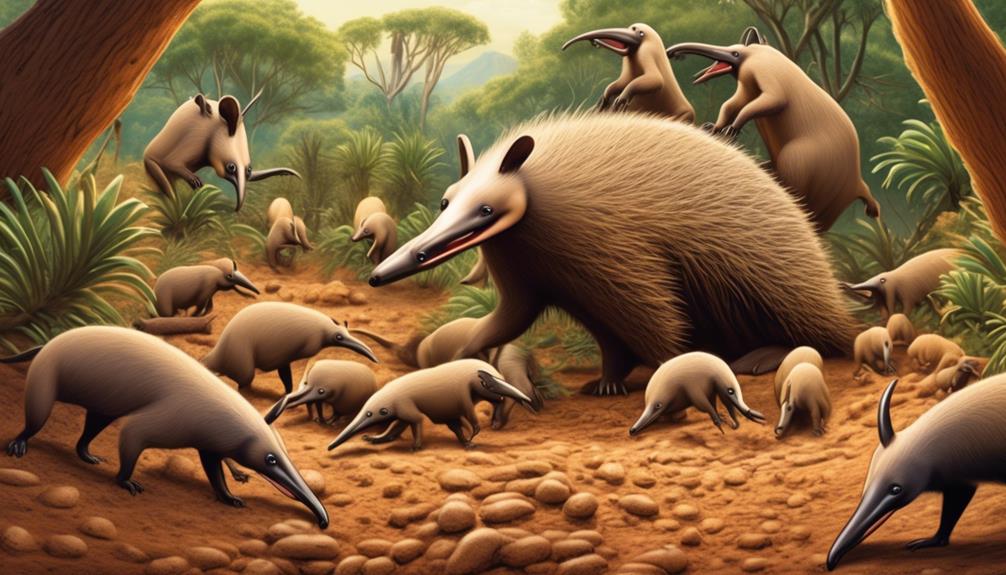Have you ever wondered about the secret world of ant and termite eaters? Prepare to be amazed as we uncover the hidden creatures that feast on these tiny insects.
From nimble predators to keen-sensed hunters, a diverse range of animals has developed unique adaptations to track down and devour ants and termites.
But it doesn’t stop there. Mammals, birds, reptiles, and even humans have found ways to incorporate these tiny creatures into their diets.
So, if you’re curious to discover the incredible variety of animals that rely on ants and termites for sustenance, join us on this journey of exploration and uncover the fascinating secrets of the ant and termite eaters.
Insects That Prey on Ants and Termites
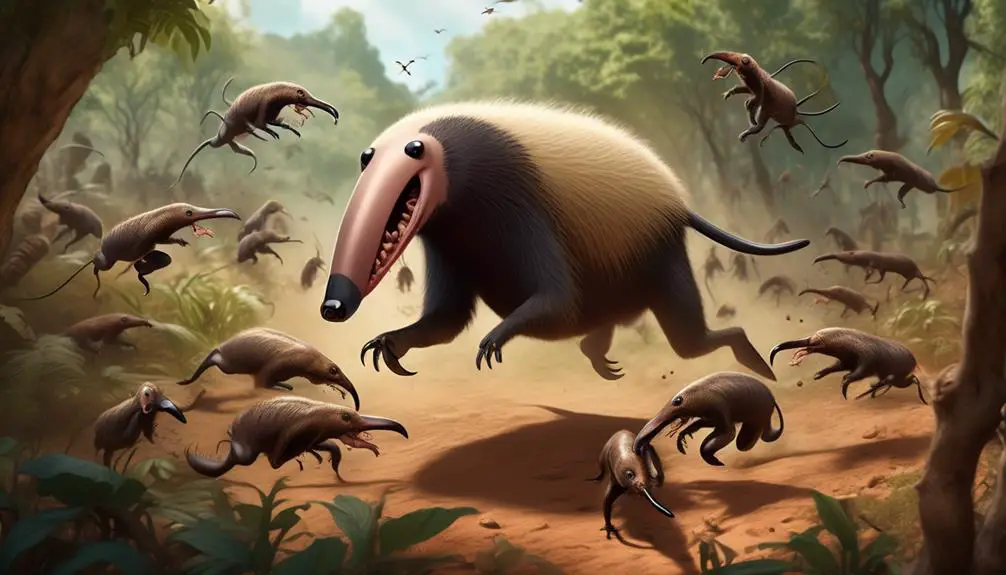
Antlion larvae, found in dry habitats, are voracious predators of ants and termites. These small insects have a unique hunting strategy that allows them to capture their prey effectively.
Antlion larvae construct cone-shaped pits in sandy soil, waiting patiently at the bottom for unsuspecting ants or termites to fall in. Once an ant or termite falls into the pit, the antlion larvae quickly seize their opportunity by flicking sand onto the prey, causing it to slide down towards the waiting jaws of the antlion.
With their strong mandibles, antlion larvae puncture the exoskeleton of their prey and inject digestive enzymes to liquefy the internal tissues. They then suck out the nutrient-rich contents, leaving behind only the empty exoskeleton.
Antlion larvae are highly specialized for this predatory lifestyle, with robust bodies and powerful jaws that allow them to subdue and consume their prey efficiently. Their ability to construct and maintain their pits is also remarkable, as they constantly patrol the edges, ensuring the pit remains intact and functional.
Mammals That Consume Ants and Termites
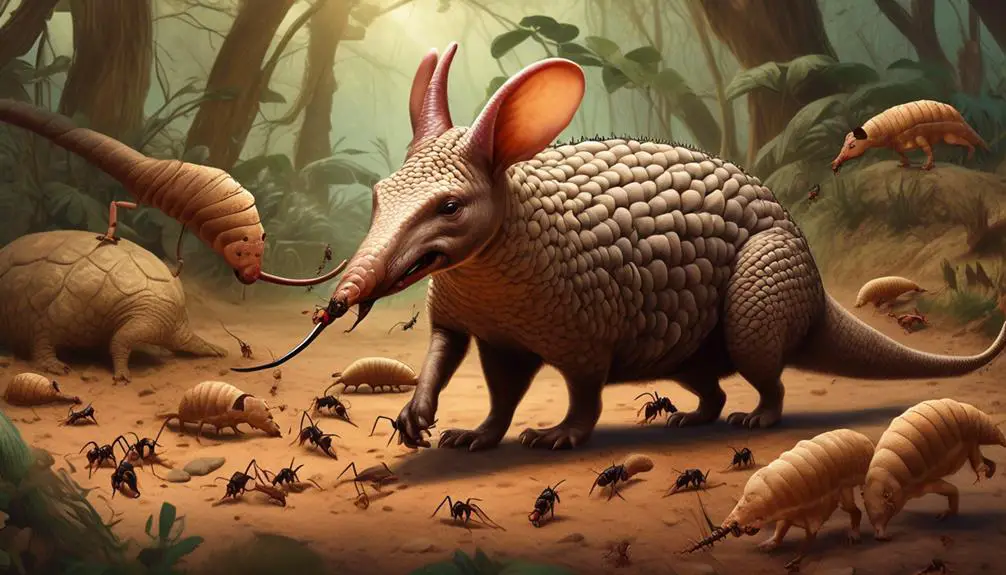
Now let’s move on to mammals that consume ants and termites.
Aardvarks and giant anteaters are two notable examples, with their specialized adaptations for hunting and consuming these insects.
Pangolins and primates, such as orangutans, also include ants and termites in their diet.
Additionally, it’s worth mentioning that humans have been known to consume ants and termites as part of their diet.
Aardvarks and Anteaters
Aardvarks and anteaters, both members of the mammalian order Edentata, are specialized insectivores that rely on consuming large quantities of ants and termites as their primary food source.
Aardvarks have long, tubular snouts and sticky tongues that they use to extract ants and termites from their nests. Their strong claws allow them to dig into termite mounds and ant hills with ease.
Anteaters, on the other hand, have long snouts and bushy tails. They use their powerful claws to tear open termite mounds and ant nests, and then extend their sticky tongues to capture the insects.
Both aardvarks and anteaters have adaptations that enable them to efficiently consume ants and termites, ensuring a steady supply of food in their natural habitats.
Pangolins and Primates
After exploring the specialized insectivores of aardvarks and anteaters, we now shift our focus to another group of mammals that consume ants and termites: pangolins and primates.
Pangolins, characterized by their armored scales, long tails, and sticky tongues, are well-known for their diet consisting of ants, termites, and other crawling insects. They use their powerful claws to break open termite mounds and anthills, and then extend their long tongues to retrieve the insects inside.
Primates, including humans and orangutans, also consume ants as a source of protein. Orangutans, found in Southeast Asia, have been observed using sticks and tools to extract ants from tree bark.
The ability of pangolins and primates to adapt to different habitats and utilize ants and termites as a food source showcases their unique foraging strategies and dietary preferences.
Humans as Consumers
Humans, as mammals, have been known to include ants and termites as part of their diet, showcasing their adaptability and utilization of these insects as a food source. In certain cultures, ants and termites are considered delicacies, providing a valuable and sustainable source of protein. The consumption of ants and termites by humans dates back thousands of years and is practiced in various regions around the world.
These insects are often collected, prepared, and cooked in different ways to enhance their flavor and nutritional value. Additionally, ants and termites are also used as ingredients in traditional medicine and as a source of natural antibiotics.
The consumption of ants and termites by humans demonstrates their resourcefulness and ability to recognize the nutritional benefits that these insects provide.
Birds That Feed on Ants and Termites
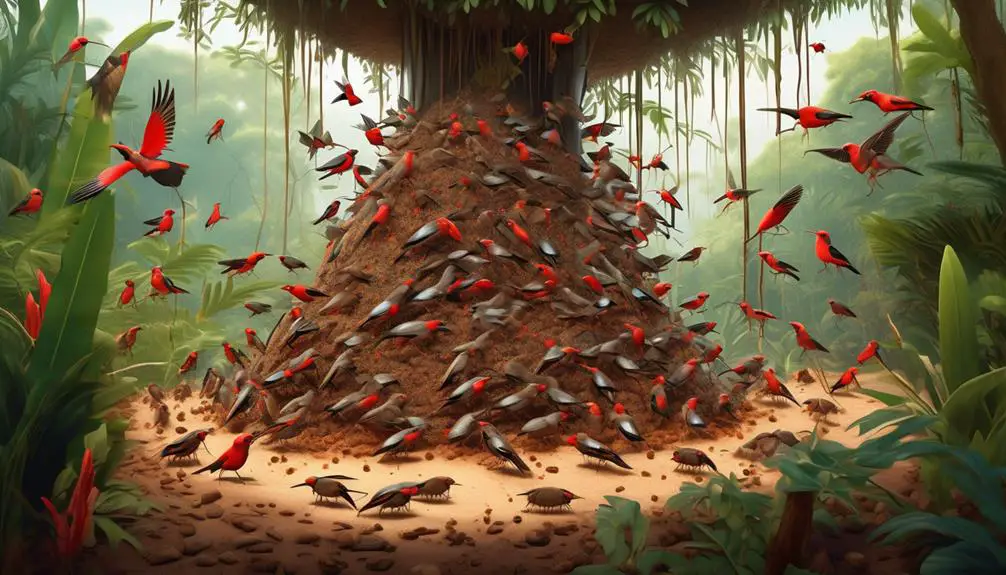
Birds that feed on ants and termites play a crucial role in maintaining the balance of insect populations within their ecosystems. These birds have developed specialized adaptations that enable them to efficiently capture and consume ants and termites.
Antbirds and antpittas are two types of birds that specifically prey on ants. They have strong beaks and agile bodies, allowing them to navigate through the intricate networks of ant colonies and capture their prey.
Flickers, a type of woodpecker, also consume ants as part of their diet. They use their strong beaks to dig into ant nests and extract the insects.
Sparrows and wrens are smaller birds that can catch a significant number of ants and survive in various habitats. They have quick reflexes and nimble movements that help them capture their prey.
Reptiles That Eat Ants and Termites
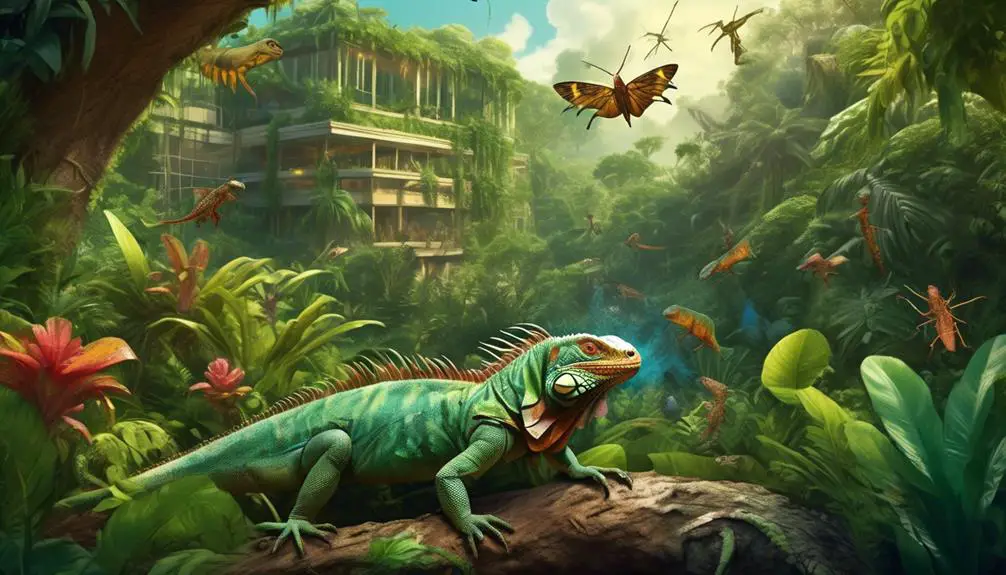
Reptiles, such as horned lizards and house geckos, are among the animals that include ants and termites in their diet. Horned lizards, native to Mexico and the Southcentral U.S., have a specialized diet that consists of mainly ants. These reptiles have a unique adaptation that allows them to shoot blood from their eyes as a defense mechanism against predators.
House geckos, commonly found in tropical areas, primarily feed on ants and termites. They’re known for their ability to climb walls and ceilings due to their specialized toe pads.
Blind snakes, tiny snakes that live underground, are another reptile that consumes ants and termites. These snakes use their sweat glands to track their prey and rely on their keen sense of smell to locate ant and termite colonies.
Some species of turtles and tortoises also consume ants and termites as part of their diet. Monitor lizards, large reptiles found in Africa, Asia, and Australia, are known to eat ants and termites. These reptiles have a strong bite and powerful jaws, allowing them to easily crush the exoskeletons of their prey.
Other Animals That Prey on Ants and Termites
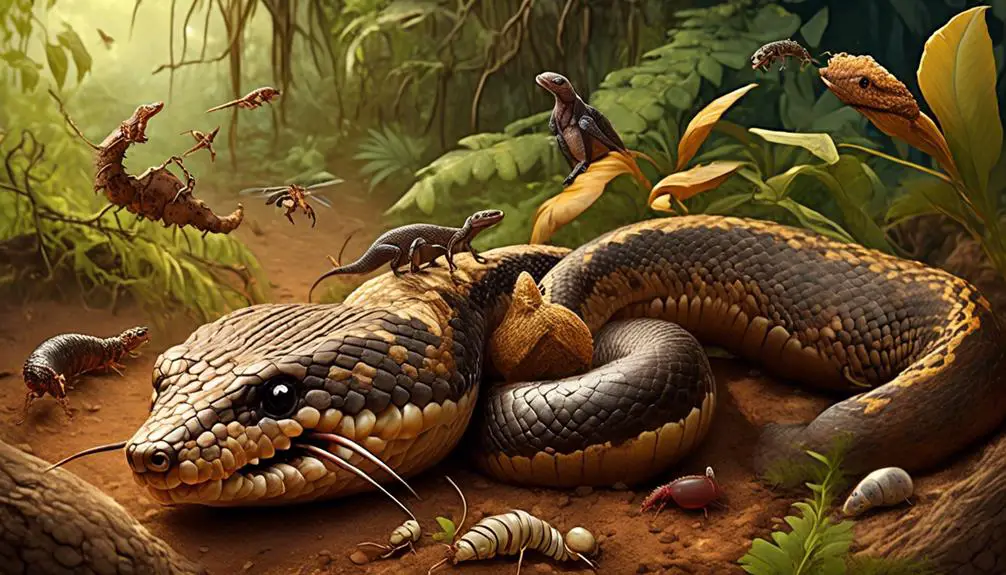
Various species of bats have been observed preying on ants and termites, adding to the diverse list of animals that rely on these insects as a food source. Bats are nocturnal mammals that possess unique adaptations for hunting and capturing their prey. They use echolocation to navigate and locate their targets in the dark, allowing them to accurately pinpoint ants and termites. Once located, bats swoop down and use their sharp teeth to capture and consume the insects.
To provide a visual representation of the different animals that prey on ants and termites, let’s look at the following table:
| Animal | Description |
|---|---|
| Bats | Nocturnal mammals that use echolocation to locate and capture ants and termites. |
| Fish (Ant Catfish) | Certain species of fish, such as the ant catfish, consume ants and termites. |
| Amphibians | Some amphibians, like the African bullfrog, include ants and termites in their diet. |
| Spiders | Various species of spiders, such as trapdoor spiders and wolf spiders, prey on ants and termites. |
| Beetles | Some species of beetles, like the ant-loving beetle, have specialized adaptations to eat ants and termites. |
These animals have evolved specific traits and behaviors to successfully prey on ants and termites. By doing so, they contribute to the regulation of ant and termite populations and play a crucial role in maintaining the balance of ecosystems.
Antlion Larvae: Voracious Ant Predators
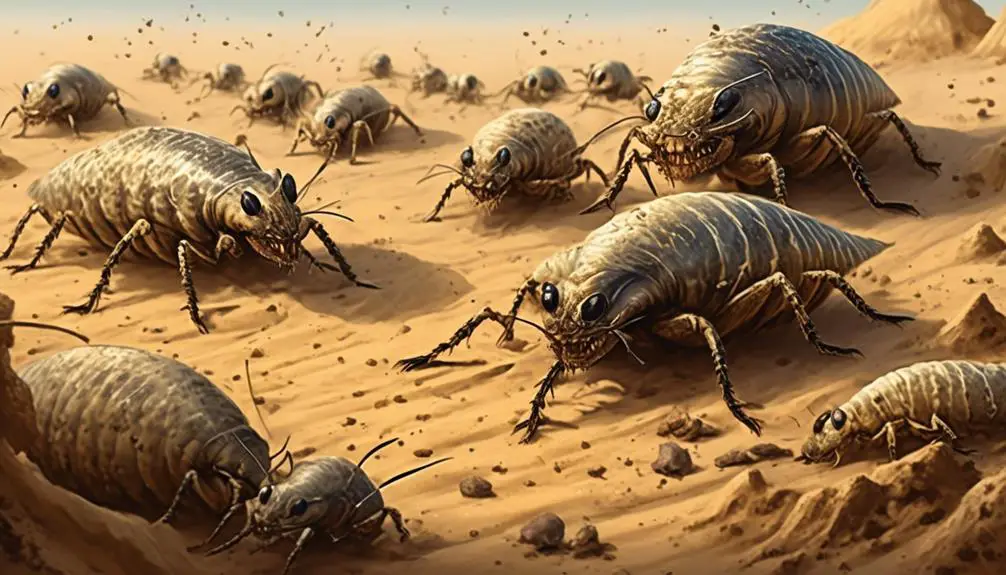
Antlion larvae employ unique hunting techniques to capture their ant prey. These voracious predators are commonly found in sandy or gravelly habitats where ants are abundant.
By constructing conical pits in the sand, the antlion larvae create traps for unsuspecting ants to fall into.
Once an ant falls into the pit, the antlion uses its sharp jaws to quickly immobilize and consume its prey.
This predation strategy can have a significant impact on ant populations in certain areas.
Antlion Hunting Techniques
Antlion larvae employ highly specialized hunting techniques to capture and consume their ant prey. These larvae are equipped with a unique anatomical structure that allows them to create conical pits in sandy or loose soil. Once a pit is constructed, the antlion larvae position themselves at the bottom, buried beneath the surface, and await their unsuspecting victims.
As ants stumble into the pit, the loose soil causes them to slide down towards the waiting jaws of the antlion larvae. With lightning-fast reflexes, the larvae snatch the ants with their strong mandibles and inject them with digestive enzymes to immobilize and break down their prey. Once the ants are incapacitated, the antlion larvae suck out their bodily fluids, leaving behind empty exoskeletons.
This efficient hunting strategy ensures a constant supply of food for the voracious antlion larvae, allowing them to thrive in their chosen habitat.
Antlion Habitat Preferences
Antlion larvae, known for their voracious appetite for ants, exhibit distinct habitat preferences that contribute to their successful predation. These larvae are commonly found in dry habitats, such as sandy areas, gravel pits, and open fields. They prefer locations with loose, well-drained soil where they can easily construct their characteristic cone-shaped pits.
The loose soil allows the larvae to create their pits with steep sides, making it difficult for ants to escape once they fall in. Additionally, antlions tend to avoid areas with dense vegetation, as it can obstruct their pit-building process and hinder their ability to capture prey efficiently.
Antlion Impact on Ant Populations
The voracious appetite of antlion larvae has a significant impact on ant populations, as they relentlessly prey on these insects. Antlion larvae are specialized predators that inhabit dry habitats and construct cone-shaped pits in sandy soil to trap their prey. Once an ant falls into the pit, the antlion larvae quickly capture it using their sharp mandibles. They then inject digestive enzymes into the ant’s body, liquefying its tissues and allowing the larvae to suck up the nutrients. This predatory behavior can decimate ant populations in an area, disrupting the delicate balance of the ecosystem. The table below summarizes the impact of antlion larvae on ant populations:
| Antlion Impact on Ant Populations |
|---|
| Antlion larvae relentlessly prey on ants |
| Their specialized traps help capture ants |
| Digestive enzymes liquefy ant tissues for consumption |
Jumping Spiders: Agile Hunters of Ants
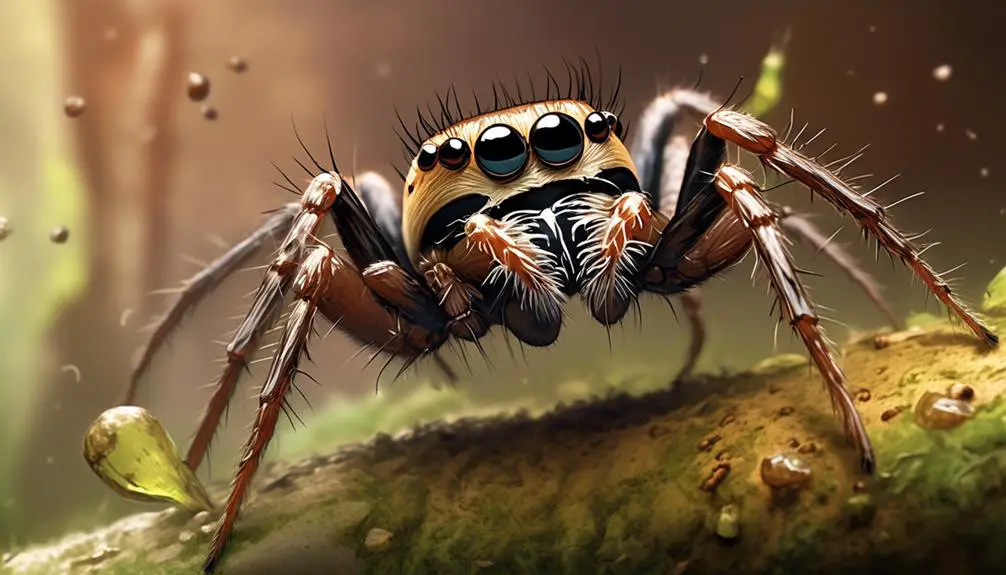
Jumping spiders, with their remarkable visual capabilities and agile hunting skills, are highly efficient predators of ants in humid areas. These spiders belong to the family Salticidae and are known for their ability to jump long distances to capture their prey. They’ve excellent vision, thanks to their large anterior median eyes, which provide them with a wide field of view and the ability to detect movement. This visual acuity allows them to spot and track ants with precision.
When hunting ants, jumping spiders use a combination of stealth and speed. They approach their prey slowly and cautiously, minimizing any vibrations that could alert the ants. Once in striking range, they pounce on the ant with lightning-fast reflexes, using their sharp fangs to deliver a venomous bite. This venom helps immobilize the ant and begins the process of digestion.
Jumping spiders are also known for their ability to mimic ants, using their body shape and movements to blend in with ant colonies. This allows them to get close to their prey without raising suspicion. Once in the midst of the ants, they can easily pick off individuals one by one, taking advantage of their superior agility and speed.
Blind Snakes: Feed on Ants and Termites
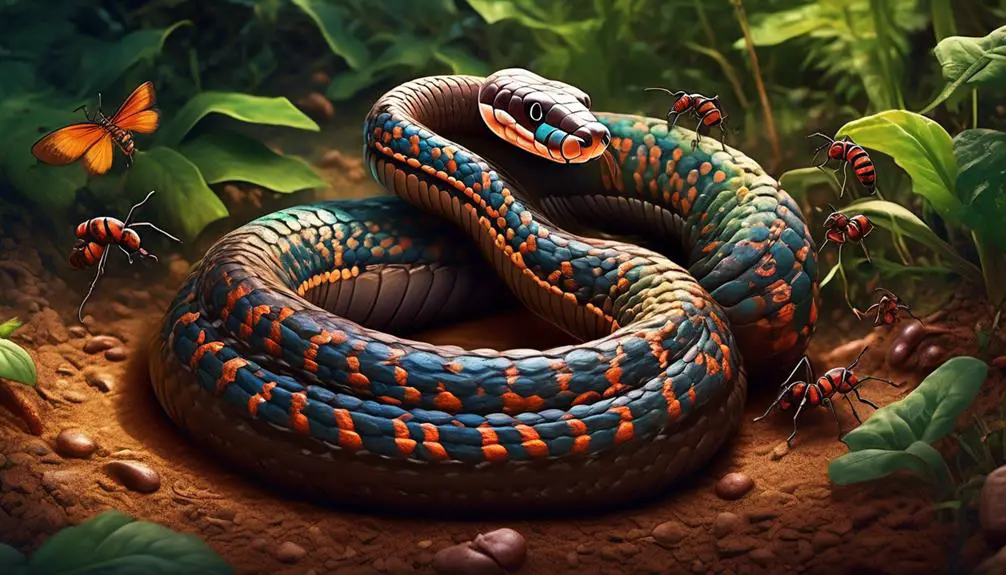
With their remarkable ability to track and capture ants, jumping spiders aren’t the only insects that excel at feeding on these tiny creatures. Blind snakes, a group of tiny snakes that live underground, also have a voracious appetite for ants and termites. These snakes belong to the family Typhlopidae and are found in various parts of the world, including Africa, Asia, and America.
Blind snakes have a unique method of locating their prey. They possess specialized sweat glands that produce a scent that attracts ants and termites. As the snakes move through the soil, these insects are drawn to the scent, allowing the blind snakes to easily locate and capture them. This tracking mechanism is vital for the survival of blind snakes, as they rely heavily on ants and termites for their diet.
Once blind snakes capture their prey, they use their small teeth to puncture the exoskeleton of the ants and termites. They then consume the soft tissues and body fluids of these insects. Blind snakes are capable of consuming large amounts of ants, termites, and their larvae, which provides them with the necessary nutrients for survival.
House Geckos: Natural Pest Controllers
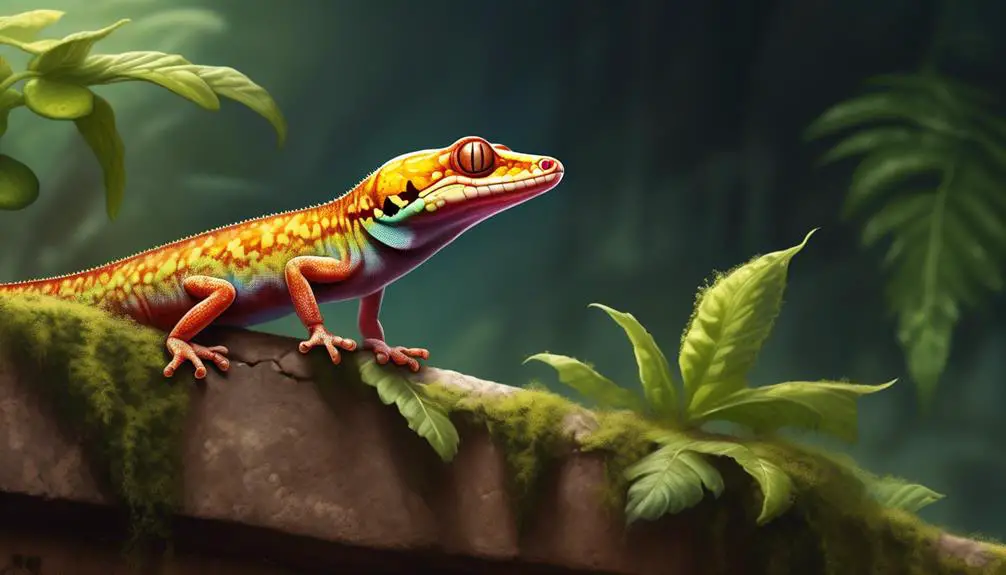
House geckos are highly effective natural pest controllers, as they primarily feed on ants and termites. These small reptiles, commonly found in tropical areas, have adapted to thrive in human habitats, making them valuable allies in pest control.
House geckos possess specialized features that enable them to efficiently hunt and consume their prey. Their long, agile tongues and adhesive toe pads allow them to easily catch and consume ants and termites. The geckos’ keen eyesight and quick reflexes aid in their hunting efforts, ensuring a high success rate in capturing their prey.
Additionally, house geckos have a high metabolic rate, which means they require a constant supply of food. This makes them voracious feeders, helping to reduce ant and termite populations in homes.
Furthermore, house geckos reproduce rapidly, with females laying multiple clutches of eggs throughout the year. This, combined with their ability to inhabit a wide range of environments, allows them to establish stable populations and provide ongoing pest control.
Aardvarks: Exclusive Ant and Termite Eaters
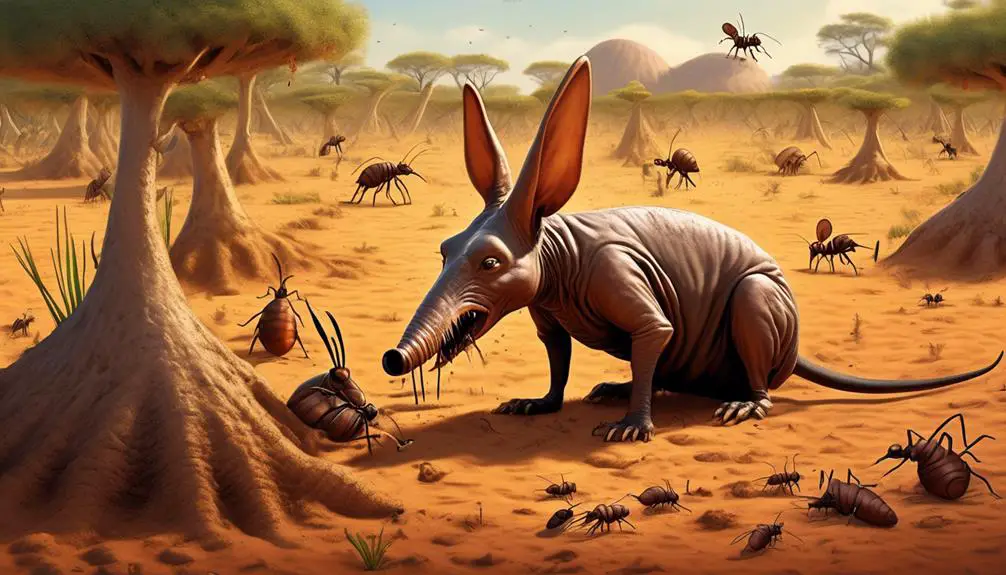
As we shift our focus to the exclusive ant and termite eaters of the animal kingdom, we now turn our attention to the fascinating creatures known as aardvarks.
Aardvarks, scientifically known as Orycteropus afer, are medium-sized mammals native to Africa. They have a unique appearance, with a long snout, large ears, and a tubular-shaped body covered in coarse hair. Aardvarks are primarily nocturnal and solitary animals, spending their nights searching for ant and termite colonies to feed upon.
Aardvarks possess several adaptations that allow them to efficiently consume ants and termites. Their long, sticky tongues can extend up to 30 centimeters, enabling them to reach deep into tunnels and extract their prey. Aardvarks also have strong claws on their forelimbs, which they use to dig into termite mounds and ant hills. They have a keen sense of smell that helps them locate their food sources, and their large ears provide excellent hearing to detect any potential threats while foraging.
The diet of aardvarks consists almost entirely of ants and termites, although they occasionally consume other insects and even small vertebrates. Aardvarks can consume up to 50,000 ants or termites in a single night, making them highly efficient predators of these social insects. They have specialized teeth, with sharp incisors and molars that are well-suited for grinding the exoskeletons of ants and termites.
Giant Anteaters: Specialized Ant and Termite Hunters
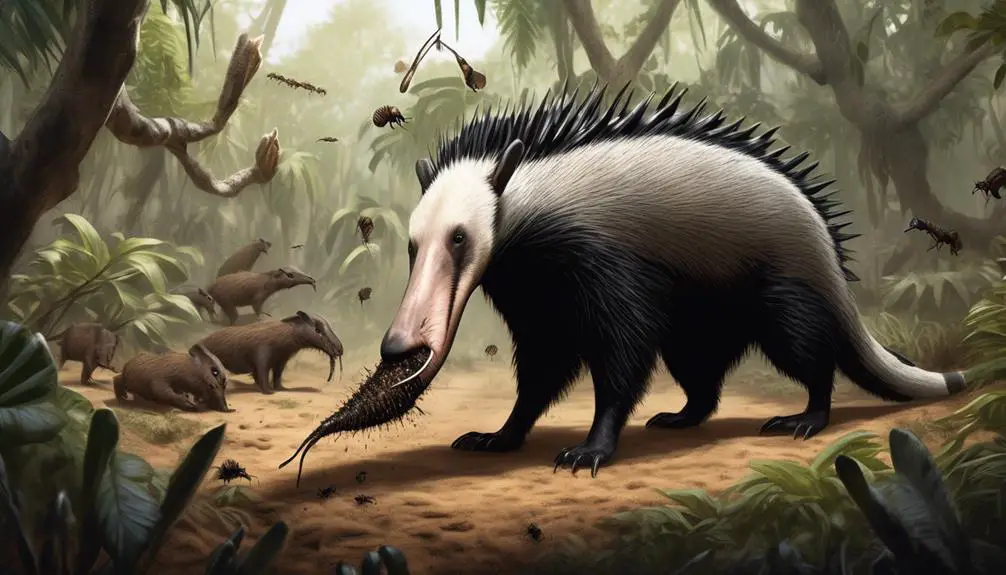
Giant anteaters possess unique hunting adaptations that make them highly specialized ant and termite hunters.
Their long snouts and bushy tails, combined with their powerful claws and sticky tongues, allow them to efficiently locate and consume their prey.
These adaptations enable giant anteaters to play a crucial role in their ecosystems by controlling ant and termite populations and maintaining the balance of their habitats.
Unique Hunting Adaptations
With their specialized adaptations, Giant Anteaters possess unique hunting techniques that allow them to efficiently capture and consume ants and termites. These adaptations include their long snouts, powerful claws, and sticky tongues.
The long snout of the Giant Anteater helps them reach deep into ant and termite mounds, while their powerful claws allow them to tear open the mounds and dig out their prey.
Once the prey is exposed, the Giant Anteater uses its sticky tongue, which can extend up to two feet, to catch the ants and termites. The tongue is covered in sticky saliva, which helps it to easily capture and hold onto the prey.
This specialized hunting technique enables the Giant Anteater to consume large quantities of ants and termites in a short amount of time, making them highly efficient predators.
Ecological Importance
The ecological importance of Giant Anteaters as specialized hunters of ants and termites lies in their unique adaptations and efficient predation methods. These large, insectivorous mammals have long, tubular snouts and strong, curved claws that allow them to dig into ant and termite nests. Their tongues are coated with sticky saliva, which they can extend up to 60 centimeters to rapidly capture their prey.
By consuming vast quantities of ants and termites, Giant Anteaters help control the populations of these insects, which can have significant ecological impacts on their habitats. Additionally, the digestion of ants and termites in the Giant Anteaters’ stomachs helps to spread seeds and nutrients, contributing to the ecosystem’s overall health and diversity.
Therefore, the presence of Giant Anteaters in their natural habitats plays a crucial role in maintaining the balance and functioning of the ecosystem.
Pangolins: Armored Insectivores
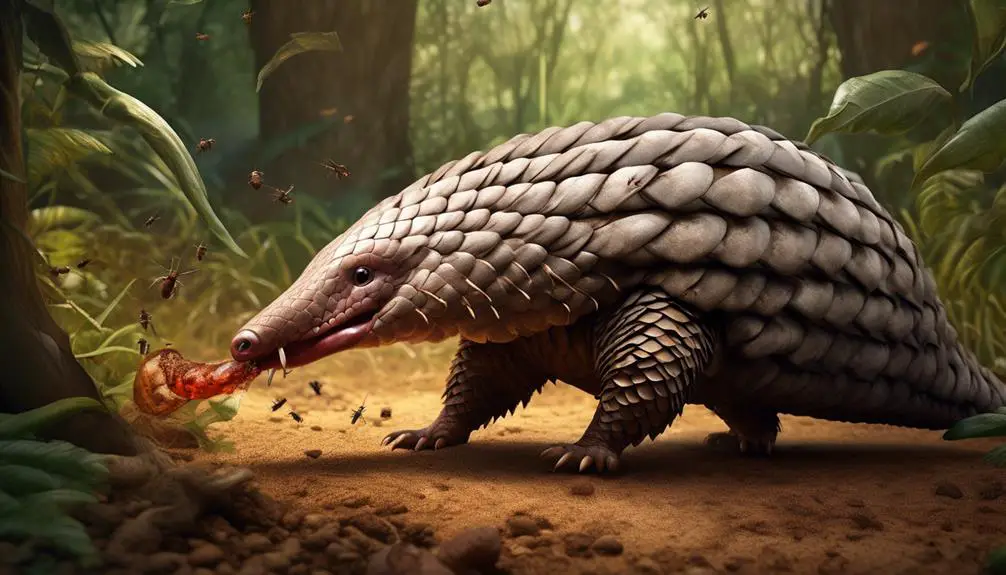
Pangolins, fascinating creatures known for their armored scales and specialized diet, are insectivores that consume ants, termites, and other crawling insects. They belong to the order Pholidota and are divided into eight different species. Pangolins have a unique adaptation that allows them to feed on ants and termites efficiently: their long, sticky tongues. These tongues can extend up to 40 centimeters, enabling them to reach deep into termite mounds and ant nests. Additionally, pangolins have powerful claws that they use to dig into the ground and tear open termite mounds.
To better understand the diet of pangolins, we have provided a table below that highlights their feeding habits and preferences:
| Species | Diet |
|---|---|
| Chinese Pangolin | Ants, termites, larvae, and pupae |
| Indian Pangolin | Termites, ants, and other insects |
| Sunda Pangolin | Termites, ants, and insect larvae |
As you can see, pangolins are specialized insectivores that have evolved unique adaptations to consume ants, termites, and other crawling insects. Their diet plays a crucial role in regulating the population of these insects, contributing to the overall balance of ecosystems. However, it is important to note that pangolins are currently facing severe threats, including habitat loss and poaching for their meat and scales. Conservation efforts are necessary to protect these incredible creatures and ensure their survival in the wild.
Humans: Ants and Termites in Our Diet
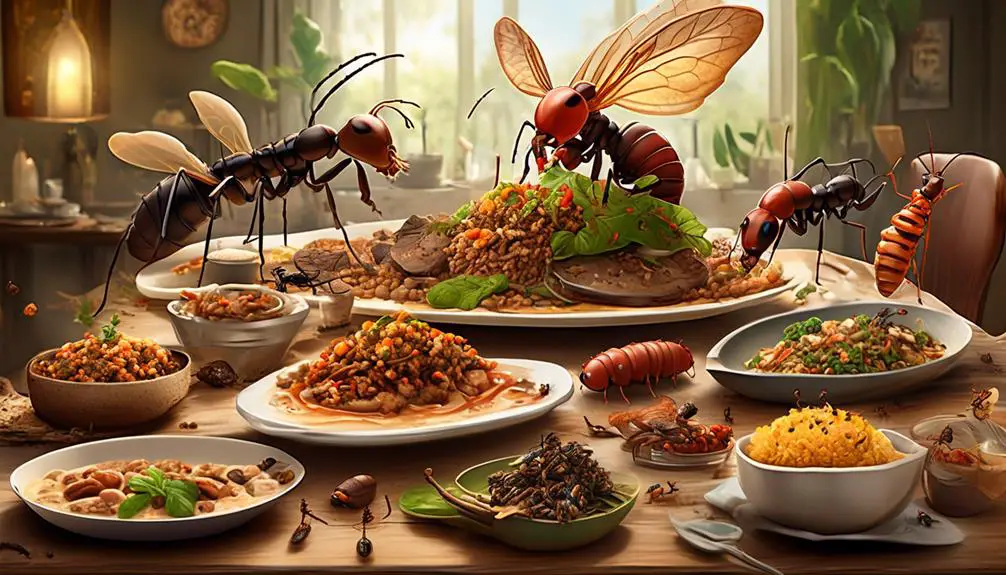
Humans have a long history of including ants and termites in their diets. These insects aren’t only a source of nutrition but also have culinary uses in different cultures.
Ants and termites have been consumed for their protein content and are often cooked or incorporated into various dishes for their unique flavors and textures.
Nutritional Value of Ants and Termites
Ants and termites, as part of the human diet, offer a significant source of nutrition. They are rich in amino acids, which are the building blocks of protein and play a crucial role in muscle growth and repair. These insects also provide essential vitamins and minerals, such as vitamin B12, iron, and zinc. Vitamin B12 is important for red blood cell production and nerve function, while iron is essential for oxygen transport in the body. Zinc plays a key role in immune function and wound healing. Additionally, ants and termites are low in fat and calories, making them a healthy and sustainable food choice. Incorporating these insects into the human diet can contribute to a well-balanced and nutritious meal plan.
Culinary Uses of Ants and Termites
Incorporating ants and termites into our diet offers a unique culinary experience with a plethora of nutritional benefits. These tiny insects are not only rich in protein but also contain essential vitamins and minerals. To help you understand the nutritional value of ants and termites, here is a table highlighting their key nutrients:
| Nutrient | Ants (per 100g) | Termites (per 100g) |
|---|---|---|
| Protein | 14g | 17g |
| Fat | 3g | 5g |
| Fiber | 0.5g | 1g |
| Calcium | 30mg | 40mg |
As you can see, ants and termites are not only a great source of protein but also provide important minerals like calcium. Additionally, their low fat content makes them a healthy choice. These insects can be prepared in various ways, such as sautéed, roasted, or added to dishes as a crunchy garnish. Incorporating ants and termites into your diet not only adds a unique flavor but also boosts your nutritional intake.
Orangutans: Southeast Asian Ant Consumers

Orangutans in Southeast Asia exhibit a unique dietary behavior as avid consumers of ants, relying on these protein-rich insects for sustenance. Known as the largest tree-dwelling mammals on Earth, orangutans are primarily frugivorous, with fruits making up the majority of their diet. However, during periods of fruit scarcity or when seeking additional sources of protein, orangutans turn to ants as a valuable food resource.
Orangutans have been observed using their long, powerful arms to access ant nests located in tree hollows, crevices, or on the forest floor. They employ a variety of foraging techniques, including using sticks to extract ants or by simply using their hands to scoop up ants from the ground. Once captured, the orangutans consume the ants by directly putting them into their mouths or by licking them off their fingers.
Ants provide orangutans with a valuable source of protein, which is essential for their overall health and well-being. The high protein content of ants helps to supplement the primarily fruit-based diet of orangutans, providing them with the necessary nutrients to maintain their energy levels and support their growth and reproduction.
Moreover, ants also offer other nutritional benefits to orangutans. Ants are rich in vitamins and minerals, including calcium, iron, and zinc, which are important for bone development, oxygen transport, and immune function. Furthermore, ants contain chitin, a complex carbohydrate that aids in digestion and provides dietary fiber.
Various Birds, Reptiles, and Amphibians: Ants and Termites on the Menu
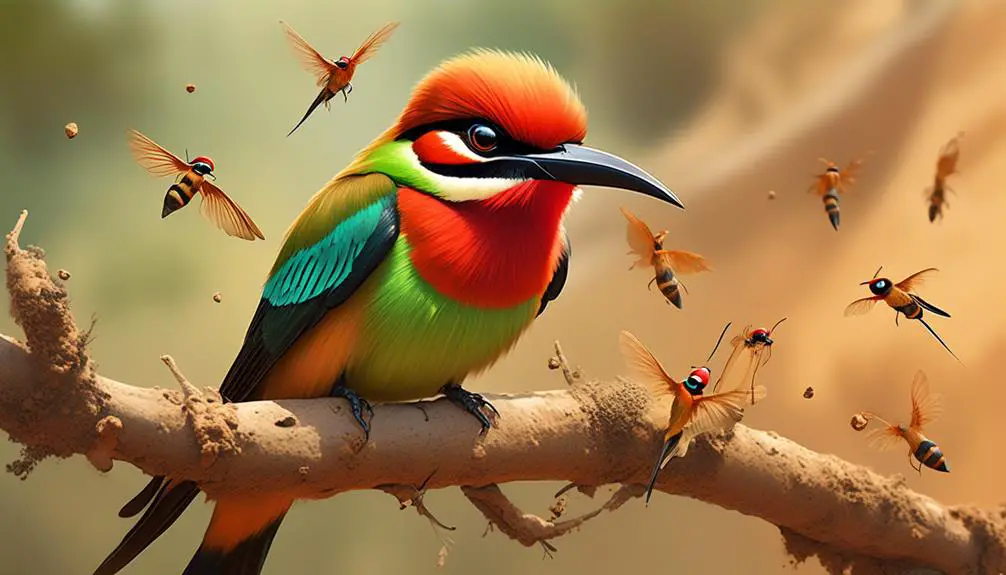
While orangutans in Southeast Asia have a specific preference for ants, there are various birds, reptiles, and amphibians that also include ants and termites in their diet.
Among the birds, antbirds and antpittas are known to specifically prey on ants. Flickers, a type of woodpecker, consume ants as part of their diet, and sparrows and wrens are also capable of catching a significant number of ants.
In the reptile world, horned lizards, house geckos, and blind snakes are among those that feed on ants and termites. Horned lizards, native to Mexico and the Southcentral U.S., include ants and other insects in their diet. House geckos, commonly found in tropical areas, primarily feed on ants and termites. Blind snakes, tiny snakes that live underground, feed on ants, termites, and their larvae.
Additionally, certain species of turtles, tortoises, and monitor lizards also consume ants and termites.
Lastly, in the amphibian realm, the African bullfrog is known to include ants and termites in its diet.
It’s worth noting that various species of spiders and beetles, as well as certain species of bats and fish, also eat ants and termites.

Erzsebet Frey (Eli Frey) is an ecologist and online entrepreneur with a Master of Science in Ecology from the University of Belgrade. Originally from Serbia, she has lived in Sri Lanka since 2017. Eli has worked internationally in countries like Oman, Brazil, Germany, and Sri Lanka. In 2018, she expanded into SEO and blogging, completing courses from UC Davis and Edinburgh. Eli has founded multiple websites focused on biology, ecology, environmental science, sustainable and simple living, and outdoor activities. She enjoys creating nature and simple living videos on YouTube and participates in speleology, diving, and hiking.

